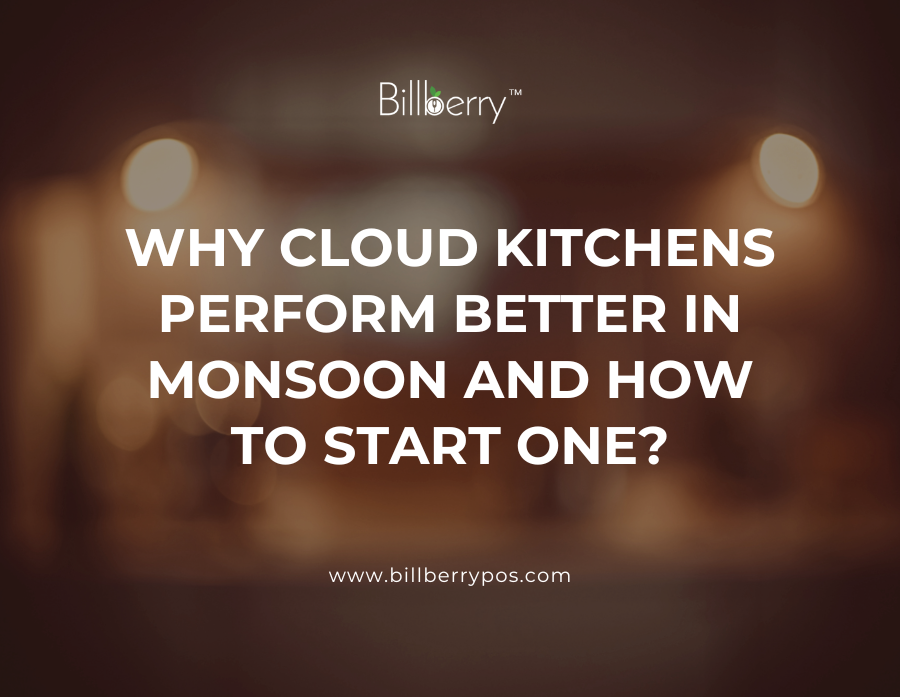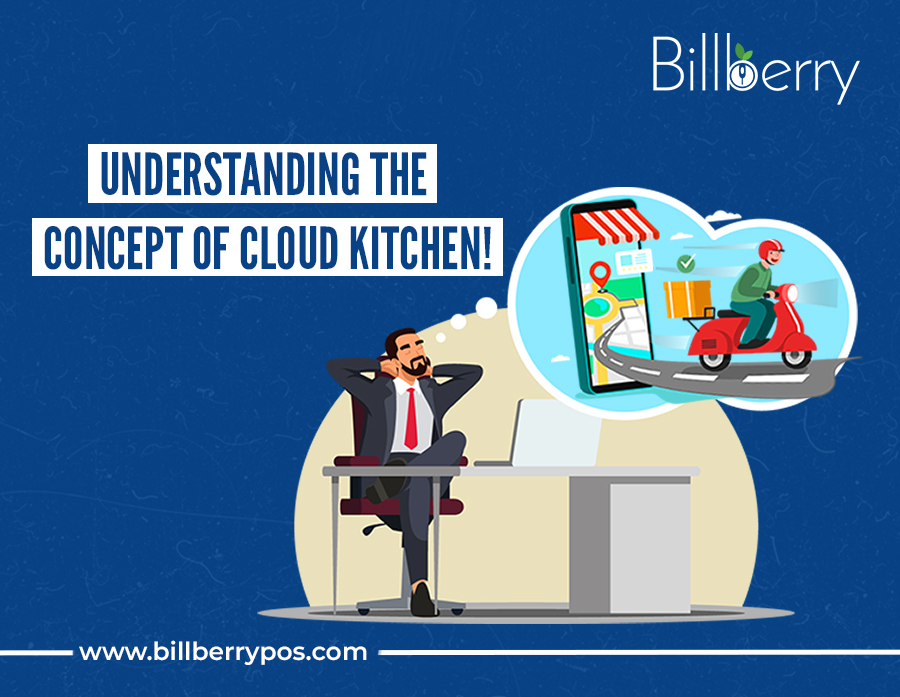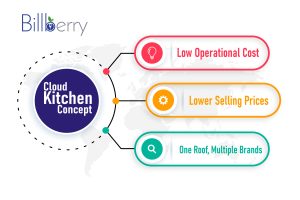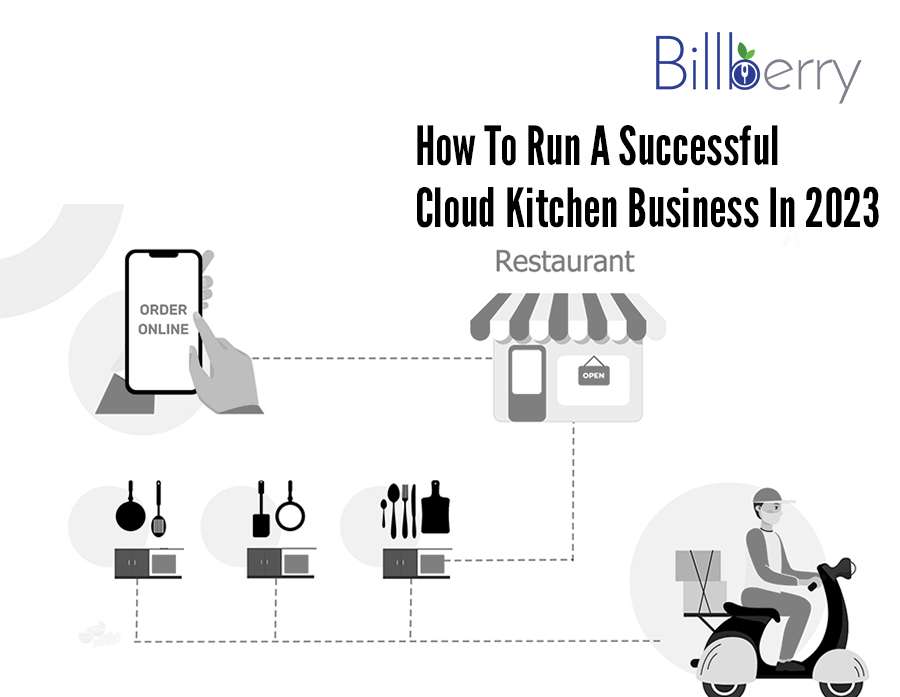Every year, as monsoon clouds roll in and rain begins to pour, food business owners brace themselves, not for booming sales, but for sluggish footfall, delivery delays, and rising operational issues. The charm of the rainy season brings comfort to customers but chaos to restaurant owners. Let’s learn why people start cloud kitchen in monsoon and it’s profitable.
Why Traditional Restaurants Struggle During Monsoon
For dine-in restaurants, the monsoon season often means:
~ Fewer walk-ins due to waterlogged roads and transportation issues
~ Longer table turnaround times with customers staying longer indoors
~ Maintenance troubles like leaky roofs, damp interiors, and power fluctuations
~ Spoilage risks for perishable inventory in humid conditions
~ Lower revenue with high fixed overheads and underutilized staff
Despite the ongoing demand for comfort food during rainy days, traditional setups face challenges that affect both service quality and profitability.
How Cloud Kitchens Offer a Smart Seasonal Solution
This is where cloud kitchens, also called ghost kitchens or virtual kitchens, emerge as the ideal solution.
They eliminate dine-in dependency, so footfall isn’t a concern.
They focus only on delivery, making them perfect for days when people prefer staying indoors.
With lower rentals, minimal staff, and digital infrastructure, they offer high operational efficiency, even when weather conditions outside are less than ideal.
Cloud kitchens can be easily optimized for seasonal menus, helping owners cater to changing cravings like soups, pakoras, and chai combos.
In simple terms, while most restaurants wait out the storm, cloud kitchens thrive in it.
Read More: India’s Most Trusted Restaurant POS Billing Software
Why Cloud Kitchens Shine in the Monsoon Season
While traditional restaurants wrestle with monsoon-related setbacks, cloud kitchens quietly thrive. Designed to be lean, flexible, and digitally connected, they’re built for unpredictable seasons like this. Here’s why they outperform others when the rain starts falling:
1. No Dine-In Dependency
With no need for customer seating or footfall, cloud kitchens stay unaffected by empty tables and soggy entryways. They operate 100% on delivery, making them immune to poor weather turnout or traffic disruptions. Whether it’s a thunderstorm or a drizzle, your orders keep flowing.
2. Lower Operational Costs
Cloud kitchens save big on overheads, no servers, no front-of-house expenses, no high-end interiors. In monsoon, when revenues fluctuate for dine-in spaces, cloud kitchens maintain healthy margins with lean staffing, compact spaces, and tech-driven efficiency.
3. Flexible, Flood-Free Locations
You don’t need to set up shop in a high-rent commercial hotspot. Cloud kitchens can be placed in low-rent, back-end areas with strong delivery access. You also have the freedom to choose non-flooding zones or elevated buildings to ensure smooth operations during heavy rains.
4. Surge in Online Orders During Monsoon
Rainy days drive comfort food cravings. Customers prefer ordering in over stepping out, and search queries for “chai-pakora near me” or “best food delivery in rain” skyrocket. Cloud kitchens are best positioned to meet this demand surge, fulfilling more orders without the chaos of dine-in pressure.
5. Menu Flexibility for Seasonal Experiments
Unlike restaurants tied to printed menus or formal SOPs, cloud kitchens enjoy full creative control. Want to launch a “Rainy Day Combo” or a “Hot & Spicy Monsoon Thali”? You can go live in hours. This freedom helps you respond to trends, cravings, and seasonal ingredients instantly.
Read More: Free POS Vs. Paid POS Billing Software
Trends Supporting Cloud Kitchens in 2025
The rise of cloud kitchens isn’t just a passing phase, it’s part of a fundamental shift in how India eats. Backed by strong market growth, changing consumer habits, and the support of major delivery platforms, 2025 is shaping up to be the golden year for cloud kitchens.
Let’s break down the key trends:
1. Market Growth Stats: Cloud Kitchens on the Rise
According to market analysts, India’s cloud kitchen market is projected to reach $2.5 billion by 2026, growing at a CAGR of 15–17%.
This growth is fueled by urban expansion, digital penetration, and increased demand for home-delivered food, especially during seasonal disruptions like monsoons.
With lower entry barriers and scalable models, more food entrepreneurs and legacy brands are adopting the cloud kitchen approach.
2. Consumer Behavior During Monsoon
Rainy days trigger comfort food cravings, hot soups, spicy snacks, momos, and fried treats.
Footfall in restaurants drops, but searches for food delivery apps and “best food near me” peak during rainy evenings.
Consumers in 2025 want fast, clean, contactless delivery with minimal delays, and cloud kitchens are perfectly positioned to deliver just that.
There’s a strong tilt toward repeat orders for reliable food providers during weather disruptions.
3. Delivery Platform Partnerships
Giants like Swiggy, Zomato, and ONDC have shifted focus toward supporting cloud kitchens.
Many offer exclusive visibility boosts, lower commission slabs, and even kitchen space partnerships.
Swiggy Access and Zomato Infrastructure Services have helped small brands scale without investing in real estate.
These platforms are investing in last-mile logistics to beat monsoon traffic, meaning better customer experience for cloud kitchen brands.
How to Start a Cloud Kitchen in Monsoon 2025
Starting a cloud kitchen is easier in 2025 than ever before, but doing it strategically during the monsoon season can give you a strong competitive edge. Whether you’re a new foodpreneur or a traditional restaurant pivoting to delivery, this step-by-step plan will help you set up a monsoon-ready cloud kitchen built for speed, hygiene, and seasonal success.
1. Choosing the Right Location
~ Your kitchen’s success is not about footfall, but about delivery efficiency.
~ Choose an area close to high-density residential or office zones.
~ Make sure the building is not flood-prone, and has good drainage.
~ A 200–300 sq. ft. kitchen is enough to start, especially if you’re running one or two brands.
~ Ensure there’s enough ventilation to manage humidity and avoid ingredient spoilage during monsoons.
💡 Pro Tip: Avoid high-rent commercial markets; use the savings for tech, packaging, and marketing.
2. Designing a Monsoon-Friendly Menu
~ Monsoon calls for comfort, warmth, and indulgence.
~ Include seasonal favorites: pakoras, momos, soups, vada pav, masala chai, hot gravies with rice/roti.
~ Offer combo meals for couples and families (e.g., “Rainy Day Combo for 2 at ₹199”).
~ Focus on food that travels well: avoid items that get soggy or lose texture fast.
~ Use limited-time monsoon specials to drive curiosity and repeat orders.
💡 SEO Tip: Add dish names people search for, like “street-style Maggi,” “spicy chicken momos,” or “chai snacks.”
3. Smart and Secure Food Packaging
~ Packaging can make or break your rainy season success.
~ Use waterproof, leak-proof, and insulated containers to maintain food temperature and prevent mess.
~ Add tamper-evident seals for hygiene assurance.
~ Invest in eco-friendly packaging with branding, it enhances trust and customer recall.
💡 Offer free tissue packs or wet wipes, small gestures go a long way in rainy season hospitality.
4. Partnering with Food Delivery Apps
~ Register your kitchen on Swiggy, Zomato, Dunzo, and emerging ONDC platforms.
~ Use local listings and promoted ads to appear on top during peak hours.
~ Get reviews early by offering introductory discounts or free items for first orders.
~ Choose a smart delivery radius (3–5 km max) to avoid delays in monsoon traffic.
💡 Track delivery performance and customer feedback in real-time, delivery delays are more common in rain, so staying proactive helps.
5. Using a Cloud-Based POS and KDS System
Managing multiple orders during a rainy evening rush? You need automation.
~ A good cloud-based POS like Billberry POS helps you:
~ Accept and sync orders from multiple apps in one place
~ Track inventory and low-stock alerts for perishables
~ Route orders to the right kitchen counter
~ Analyze what sells best during monsoon
~ A Kitchen Display System (KDS) replaces paper tickets and boosts efficiency.
💡 Go for software that works well on mobile and allows remote monitoring.
6. Running Monsoon Marketing Campaigns & Offers
~ Create offers that match the mood of the season.
~ “Free Chai with Orders Above ₹299”
~ “Rainy Day Deal — Buy 1, Get 1 Pakora Box”
~ “Weekend Monsoon Thali at 25% Off”
~ Promote through Instagram Stories, WhatsApp Broadcasts, and Zomato/Swiggy promos.
💡 Don’t forget to name your offers creatively, “Baarish Bites,” “Thanda Dil, Garam Meal,” etc.
Read More: What Every Restaurant Can Learn From Chilli’s Viral Comeback!
Bonus Tips for Monsoon Success
Even the most efficient cloud kitchens need a few extra tricks up their sleeve to stay ahead, especially during unpredictable monsoon days. Here are some smart add-ons that can help you operate smoothly, boost visibility, and enhance customer experience.
1. Local SEO Strategy: Be Found When People Search
When it rains, people search more, especially with location-based intent like:
~ “Best food delivery near me”
~ “Rainy day snacks in [City Name]”
~ “Hot food delivery in [Locality]”
To show up in those searches:
~ Add Google Business Profile with accurate pin, timings, menu, and images.
~ Use seasonal keywords in your delivery app descriptions and website meta tags (e.g., monsoon snacks delivery, chai near me, cloud kitchen rainy day food).
~ Create Instagram Reels or posts tagged with local hashtags like #AhmedabadEats, #RainyDayCravings, #MonsoonFood2025.
💡 Pro Tip: Ask happy customers to leave Google Reviews mentioning your monsoon-friendly menu or packaging. These help with search ranking!
2. Group Meal Offers for Families & Offices
~ Rain keeps people indoors, with families, flatmates, or office teams ordering together. Serve this demand by:
~ Creating sharing packs (e.g., “Family Rainy Combo for 4 – ₹499”)
~ “Office Rain Relief Meals” during lunch hours
~ “Netflix & Nibble” combos for evening binge-watching customers
~ These orders increase average ticket size and bring in repeat business during wet weekends.
💡 Mention “ideal for 2/4/6 people” clearly in menu titles to increase clicks.
3. Backup Essentials: Be Rain-Proof from the Inside
No matter how great your kitchen setup is, the monsoon can throw surprises, power cuts, water shortage, or delayed suppliers.
Prepare with:
~ Backup power supply (inverter or generator) to avoid downtime
~ Clean water storage for food prep and cleaning
~ Inventory buffer of fast-moving SKUs (like tea, oil, packaging) in case of delivery disruptions
~ Rain protection for delivery staff, like branded raincoats or insulated bags
💡 Pro Tip: If you use a POS like Billberry, get real-time low-stock alerts to never run out unexpectedly.
Real-World Insight: How Brands Are Reinventing the Food Game with Cloud Kitchens
While independent foodpreneurs are testing the cloud kitchen waters, many established restaurant chains and new-age food brands are doubling down on the cloud-first approach, not just as a side hustle, but as their core business model.
Here’s how real-world strategies are evolving in 2025:
1. The Hub & Spoke Model: One Kitchen, Multiple Brands
One of the most successful cloud kitchen models today is the Hub & Spoke system.
How it works:
~ A central kitchen (hub) prepares the core ingredients (like gravies, batters, or par-cooked items).
~ Multiple satellite kitchens (spokes) located in delivery hotspots do the final assembly and dispatch.
~ This reduces prep time, ensures consistency, and speeds up delivery without expanding full kitchens everywhere.
Why it matters in monsoon:
~ Operations stay smooth even if a spoke faces weather issues, the hub can reroute prep.
~ Brands reduce wastage and optimize staffing across all units.
~ It’s scalable without the heavy real estate or manpower demands of traditional expansion.
💡 Use case: A single entrepreneur can run 3 virtual brands from one hub, e.g., a momo brand, a biryani brand, and a snacks brand; catering to different cravings under one roof.
2. Why Brands Are Going Cloud-First in 2025
Leading food businesses are skipping high-rent flagship stores and going “delivery-only” from day one. Here’s why:
~ Lower entry barriers: No interior design, dine-in furniture, or large staff required.
~ Faster ROI: Many kitchens break even in 3–6 months due to focused operations.
~ Location freedom: Brands can set up close to demand zones, not retail hotspots.
~ Brand experimentation: Launch new cuisines or concepts under different names with minimal risk.
~ Easier tech integration: POS systems, inventory, customer data, and marketing tools can be managed centrally across all brands and locations.
In essence, the cloud-first model is lean, scalable, data-driven, and monsoon-proof, making it the preferred path for modern food entrepreneurs and legacy brands alike.
Read More: Is Opening A Cafe Profitable in 2025?
Conclusion: Monsoon as a Growth Opportunity
For most traditional restaurants, the monsoon season is seen as a lull, a time when walk-ins drop, logistics get complicated, and sales take a hit. But for smart foodpreneurs and future-ready brands, monsoon is a window of opportunity.
With the right model, tools, and timing, this so-called “slow season” can become your launchpad for long-term growth.
Turn the Rain Into Revenue
While others wait out the weather, cloud kitchens thrive by serving exactly what people crave, warm, comforting food delivered to their doorstep.
By starting during the monsoon, you gain real-time experience, understand seasonal demand patterns, and build a loyal customer base before the festive season rush begins.
📌 Don’t wait for perfect weather. Start when the opportunity is real, and it’s raining right now.
Ready to Build a Cloud Kitchen that Performs in Any Season?
Whether you’re launching your first virtual brand or scaling multiple kitchens across the city, Billberry POS gives you the tools to:
~ Manage multi-brand operations from one dashboard
~ Track inventory and ingredient-level wastage in real-time
~ Accept & sync orders from Swiggy, Zomato, ONDC, and more
~ Run monsoon campaigns and loyalty offers effortlessly
~ Analyze performance by dish, brand, and kitchen location
Billberry isn’t just a POS, it’s a cloud kitchen growth engine.
👉 Book Your Free Demo Now and let our team help you go live this monsoon.















